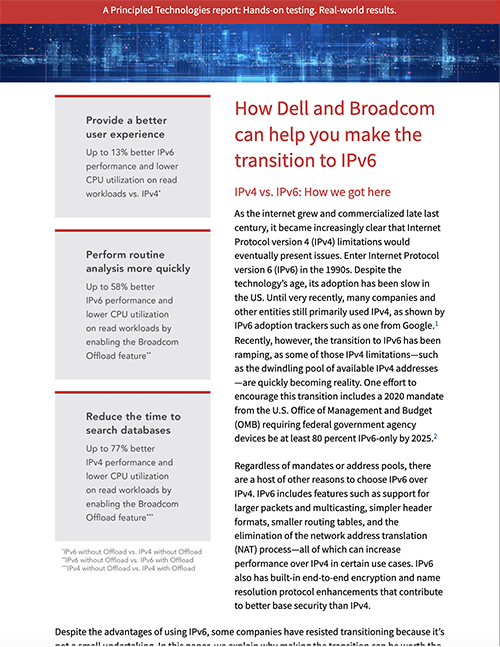
Since the turn of the century, worldwide internet use has grown exponentially, from wired home desktops and internet cafes to widespread access and, in many areas, multiple mobile and IoT device connections per person. With tens of billions of internet-connected devices in the world, network administrators are facing a dwindling pool of available Internet Protocol version 4 (IPv4) addresses.
In anticipation of this growth, engineers created IPv6. Beyond enabling trillions of addresses, IPv6 includes features such as support for larger packets, multicasting, the elimination of the network address translation process, better built-in security, and more. Each of these IPv6 benefits can improve network performance over IPv4 in certain use cases.
Despite the advantages of transitioning from IPv4 to IPv6, some organizations have avoided the process because of the complexities involved. In recent tests, we showed how a Dell PowerEdge server with Broadcom NIC can help ease the IPv6 transition and provide significant performance improvements that make it well worth the investment.
The solution we tested included Dell PowerEdge R660 servers, 100GbE Broadcom 57508 NICs, and a Dell PowerStore 1200T storage array. The Dell server and storage stack included full U.S. Government IPv6 (USGv6) certification. The USGv6 program develops, tests, and maintains IPv6 standards to help companies and government agencies ensure successful IPv6 transitions and deployments. The USGv6 certification indicates that Dell designed the gear to meet official IPv6 standards.
We tested the Dell and Broadcom solution’s performance in real-world IPv4 and IPv6 environments. We conducted tests in each environment both with and without the Broadcom Offload feature, which enables NICs to manage some network-related compute loads typically handled by the CPU. In our testing without Broadcom Offload, IPv6 delivered comparable performance to IPv4 on write workloads and up to 13 percent better performance on read workloads, all while reducing CPU utilization. When we enabled Broadcom Offload on both IPv6 and IPv4, read workload performance increased by up to 58 percent and 77 percent, respectively, and CPU utilization on both read and write workloads improved.
Whether an organization decides to transition to IPv6 or stick with IPv4, we saw that this Dell and Broadcom solution with the Broadcom Offload feature can deliver strong network performance and efficiency, putting IT administrators in an excellent position to handle future growth.
For more information about how Dell servers and Broadcom NICs can help organizations with the IPv6 transition, check out the report below.
Principled Technologies is more than a name: Those two words power all we do. Our principles are our north star, determining the way we work with you, treat our staff, and run our business. And in every area, technologies drive our business, inspire us to innovate, and remind us that new approaches are always possible.






